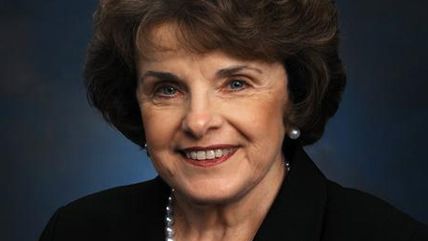Is Dianne Feinstein Responsible for the Amtrak Crash that Killed Eight? No, But Government Safety Mandates Can Have Tragic and Unintended Consequences.
Congress's decision to mandate an expensive and complicated safety system made American travelers less safe.


When news broke that the likely cause of last week's Amtrak crash was that the engineer was doing 106 on a 50-mph curve, liberal pundits were left scrounging for a ways to use this tragedy to make a case for spending more federal tax dollars on passenger rail. The narrative that needed to be retrofitted to the facts was that Republican lawmakers had blood on their hands for blocking efforts to give Amtrak the vital money it needed to safely run its trains.
And so they discovered Positive Train Control (PTC), a technology that up until last week only rail geeks had heard about. (What news editor would let a phrase like that slip past the red pen?) PTC is a system that uses radio signals and GPS to prevent trains from speeding, and in 2008, a federal law mandated that all passenger rail systems install it by the end of 2015. Though overall federal (and state) subsidies to Amtrak have climbed every year since, Congress didn't directly providing funds for PTC's implementation.
PTC would have prevented last week's crash, but Amtrak didn't have it installed yet on the track where last week's crash occurred.
"Republican Cuts Kill…Again," was the headline of a shamelessly misleading and inaccurate video posted by the Agenda Project Action Fund, a liberal policy group. "Currently Available Technology May Have Prevented Fatal Amtrak Crash. But Congress Never Funded It," was the title of a Think Progress post by Josh Israel.
What these big government opportunists chose to ignore is that PTC never made sense in the first place. That's because it's wildly expensive without much benefit, as Baruch Feigenbaum, a transportation policy analyst with the Reason Foundation, noted in a recent blog post:
The Federal Railroad Administration (FRA) places the cost at more than $13 billion to install and maintain a nationwide class I PTC system. Consulting firm Oliver Wyden estimated that PTC has a 20 year benefit between $0-$400 million. Even if all $400 million in benefits are realized, the cost/benefit ratio range is $1 in benefits for every $20 spent on the system.
PTC also involves use of the spectrum, so installing it means coordinating with the Federal Communications Commission (FCC), which is exactly the sort of complex management challenge a dysfunctional organization like Amtrak isn't up to.
But there's another safety technology that could have prevented last week's crash, which does make a lot of sense. As Feigenbaum writes:
The most obvious solution would be to expand Amtrak's existing automatic train control system that regulates speed. Automatic train control systems can be programmed to send information to a train about the speed limit for a section of track…If the technology was installed on the northbound track [where last week's accident occurred], the train likely would have gone around the curve at 80 miles per hour and not come off the track.
The 2008 mandate for PTC got pushed through Congress only because of a 2008 train crash in California:
Even before the final safety report [for that accident] was released, Sen. Dianne Feinstein (D-Calif.) began pushing to mandate automated safety equipment for all large railway systems…Swept up in the emotion, Congress in 2008 failed to seriously consider any solution except PTC. The PTC bill passed October 16, 2008 with limited debate only a month after the crash.
After last week's crash, Amtrak quickly went with the cheaper and more logical soultion, and installed an Automatic Train Control (ATC) system on the stretch of track where the accident occurred in one weekend.
While it's true that PTC works better than ATC at preventing crashes, in a world of scarcity and tradeoffs, the most expensive and complicated system is often the worse choice. As the Competitive Enterprise Institute's Marc Scribner notes in a sharp piece on the lessons of last week's crash, all that extra money for PTC would have been better spent on improving grade crossings, where on average about 270 people are killed each year. Train derailments, by contrast, are incredibly rare.
So is it possible that if Dianne Feinstein and other lawmakers hadn't pushed the PTC mandate, Amtrak would have gone ahead and installed ATC throughout the Northeast Corridor, and then eight people wouldn't have died last week? If they hadn't mandated PTC, would that extra money have gone to saving lives at grade crossings?
Who knows, but I think counterfactuals of this sort are shallow and unproductive. The only thing we know for sure is that when government officials try and make the world a safer place by fiat it can lead to unintended consequences that get people killed.
I wrote about Amtrak for The Daily Beast back in 2013: "Amtrak Is a Tax-Sucking Behemoth That Deserves to Die."

Show Comments (80)